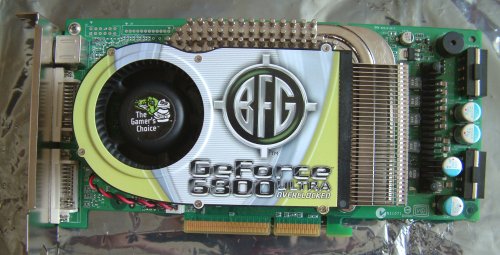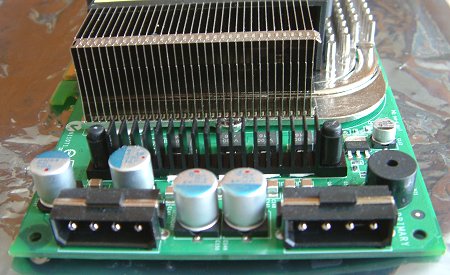Appearance and thoughts
A GeForce 6800 Ultra is a GeForce 6800 is a GeForce 6800 Ultra, right?. One would think so, but the reality is that NVIDIA's board partners are specifying a number of different core and memory clocks for their respective 6800 Ultra cards. From what I can gather, a partner can call a card an Ultra if it runs at a minimum of 400MHz core and 1100MHz memory. Anything above that is down to partners' discretion.The card-naming strategy, which is 6800U OC for this model, tells us that the base specification just isn't enough for BFG. You kind of need overclocked cards to do the company's initials justice, too, don't you?. Anyway, BFG's 6800 Ultra clocks in at 425MHz core (25MHz above a default Ultra) and 1100MHz memory (default).

Having given BFG a build-up, it's a touch disappointing to see the company stick fervently with NVIDIA's reference design to the letter. From our reviewing experience, the only visual difference between XFX, AOpen and BFG 6800 Ultras has been in company-branded cooler plates. That's it!. As always, there's nothing intrinsically wrong with reference designs, it's just that spending almost £400 on a graphics card should result in greater design diversity, especially as many enthusiasts now have windowed cases.

A side shot shows why the reference card, and all cards based upon it, need to take up 2 expansion slots. This is one area where ATI firmly has the lead. Its cards are smaller, sleeker and take just the expected AGP slot and back plane up. That's all the more surprising as 6800 Ultras run between 400-450MHz core, whereas ATI's X800 XT PEs clock in at a lofty 520MHz. ATI's use of a low-k dielectric manufacturing process and 62m fewer transistors (160m vs. 222m for NVIDIA) is the reason why it can get away with a single-slot, single-molex design.

Another NVIDIA-related drawback is the necessity to run two Molex power connectors. NVIDIA advocates running both from separate lines, powered by a PSU with at least a 480-watt rating. One can see why, as the average 6800 Ultra draws up to 110w on its own. Note the huge finned heatsink assembly that's required to keep the burning NV40 core cool.

Dual-DVI almost makes up for the card's bulkiness. This feature isn't peculiar to BFG. Rather, it's firmly entrenched in NVIDIA's NV40 specifications. Fat-walleted enthusiasts may wish to add a couple of large DVI-equipped TFTs to enhance their gaming experience.

The back is strictly reference material. BFG's also decided that a VIVO chip isn't worth adding to this cutting-edge card. Memory-wise, the BFG 6800 Ultra uses industry-standard 256MBs of 1.6ns GDDR3 from Samsung, giving plenty of headroom above the 1100MHz default memory speed.
I'm left a little deflated by BFG's 6800 Ultra. It seems as if very few partners are willing to buck the reference trend, and that goes for ATI as much as NVIDIA's AIBs. Still, an extra 25MHz core speed, which equates to 6.25%, is worth more than fancy RAMsinks and non-reference coolers, I suppose.









